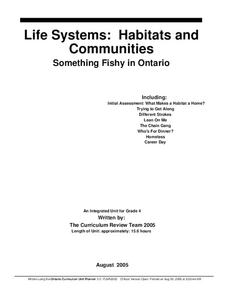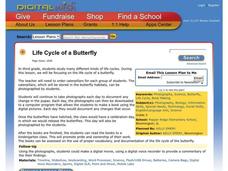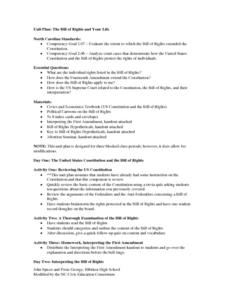Baylor College
Needs of Living Things: Pre-Assessment
Determine your class's prior knowledge about the necessities of life with this pre-assessment for a unit on living things. Learners draw pictures of themselves with all the things they need to live, grow, and survive. These drawings will...
Baylor College
Plant or Animal?
Teach your class about the necessities of life using the book Tillena Lou's Day in the Sun. After a teacher-read-aloud, students make puppets depicting different plants and animals from the story and illustrating the habitat in...
Curated OER
Something Fishy in Ontario
Students create a diorama of the habitat of the fish of their choice, along with a research paper. They research habitats, the factors which affect specific habitats, and how fish adapt to different habitats in order to meet their unique...
Curated OER
Life Cycle of A Butterfly
Third graders study the life cycle of the butterfly. In this life cycle lesson, 3rd graders observe caterpillars in their classrooms. Students put the caterpillars in butterfly habitats and photograph them at each stage of their growth....
Curated OER
Take Me to Sesame Street!
Students will apply concepts learned in genetics, such as Punnett squares and pedigree charts, in creating their own monster family. Also they will work cooperatively with a partner to create their monster family.
Curated OER
Importance of Marine Protected Areas: an Overfishing Simulation
Students simulate overfishing by conducting a guided experiment in the classroom. For this ecology lesson, students discuss the environmental consequences of overfishing. They research additional information about the issue and share...
Curated OER
Life Cycle of the Butterfly
Students investigate the life cycle of butterflies. In this butterfly lesson, students record the life cycle of a butterfly using digital cameras. Students make digital books or slide shows at the end of the project.
Curated OER
Science Puzzlers, Twisters, and Teasers: The History of Life on Earth
A somewhat amusing assignment, this worksheet lists statements that an ancient organism may have made and asks learners to determine what geologic era that each may have lived in. It uses witty word puzzles and fill-in-the-blank-style...
Curated OER
What Do Soils Have to Do With Me?
In this identifying ways we use soils every day worksheet, students investigate their houses, home environment, clothing labels, and foods to see what was made from things grown in soils. Students write 5 short answers.
Curated OER
The Bill of Rights and Your Life
Students review the contents of the Constitution by taking a trivia quiz and brainstorm the rights contained in the Bill of Rights. After discussing the Bill of Rights, students categorize and outline its content. Given a worksheet,...
Baylor College
Needs of Living Things: Post-Assessment
Assess your class's knowledge of the needs of living things with the final lesson in a series. Given a large piece of paper and coloring utensils, young scientists draw a picture of themselves and a plant or animal of their choosing,...
Baylor College
Need or Want?
Even as adults it can be hard to distinguish needs from wants. Using pictures of common, everyday items, children make a pocket chart separating the objects they need from those that they want. Discuss their choices, explaining that...
Baylor College
Air and Breathing
Blow some bubbles and learn how living things need air in the eighth lesson of this series. Young scientists investigate this important gas by observing bubbles and monitoring their own breathing. A simple and fun activity that raises...
American Museum of Natural History
A Whale of a Tale
What's the most interesting fact about a blue whale? Learners read an interview about the similarities between the Titanosaur and the blue whale displays at the American Museum of Natural History. Pupils learn not only about blue whales...
Curated OER
Life Cycle of Frogs
In this frogs instructional activity, students analyze and color a diagram of the life cycle of frogs from egg to tadpole to full-grown frog.
Baylor College
Needs of Plants
What better way to learn about plant life than by creating a class garden? Young botanists start with a brief discussion about radishes before planting seeds and watching them grow. To determine the importance of water,...
Curated OER
A House for Me- Ocean Environments
Students explore ocean environments. In this ocean environment lesson, students identify the things ocean animals need for survival. Students use KWL charts and search the Internet collecting information about ocean habitats....
Florida International University
Are You Concentrating?
Explore the importance of a concentration gradient in the rates of dissolution. Using the ocean ecosystem, learners study rates of dissolution around coral reefs. A hands-on experiment helps individuals discover the effects of changing a...
Earth Day Network
Forms of Energy
Give me a home where electric buffalo roam and I'll show you an ohm on the range. Introduction your classes to potential and kinetic energy, electricity, and renewable resources with a resource that combines observation, direct...
Curated OER
Children Just Like Me: Celebrations!
Students read literature that is multicultural in order to investigate the types of celebrations that people have in relation to holidays around the world. They can link up with different celebrations looking for similarities to how the...
Curated OER
Insects
Students study the characteristics and basic needs of insects. They compare and describe similarities among insects. They examine the body structure, covering, and movement of insects and also, examine insect life cycles in this unit of...
Curated OER
Puberty: Day 2
Learners investigate human health by researching sexual health facts. In this puberty lesson plan, students identify the changes that will occur in a teenage body over the next several years and what the eventual outcome will be....
Curated OER
Little Me in a Big World: Ants
Students use the life cycle of an ant to learn about their own self-esteem. In this self-esteem instructional activity, students read books about ants and discuss obstacles from the stories as well as the ant behavior.
Curated OER
Sustainability and Extinction
Galapagos Penguins are the only penguins on earth that live north of the equator (in the wild). In this last lesson plan a discussion on how the Galapagos islands developed their populations and diversity sparks the introduction. Two...























